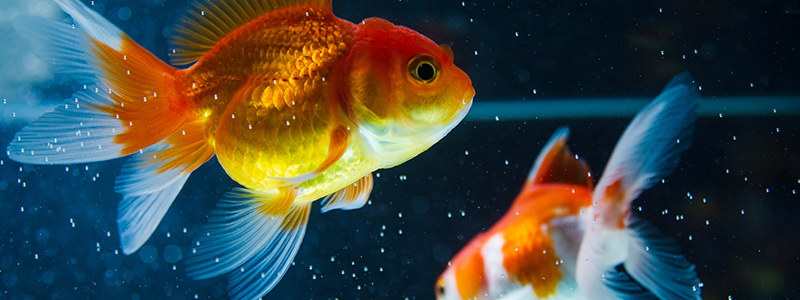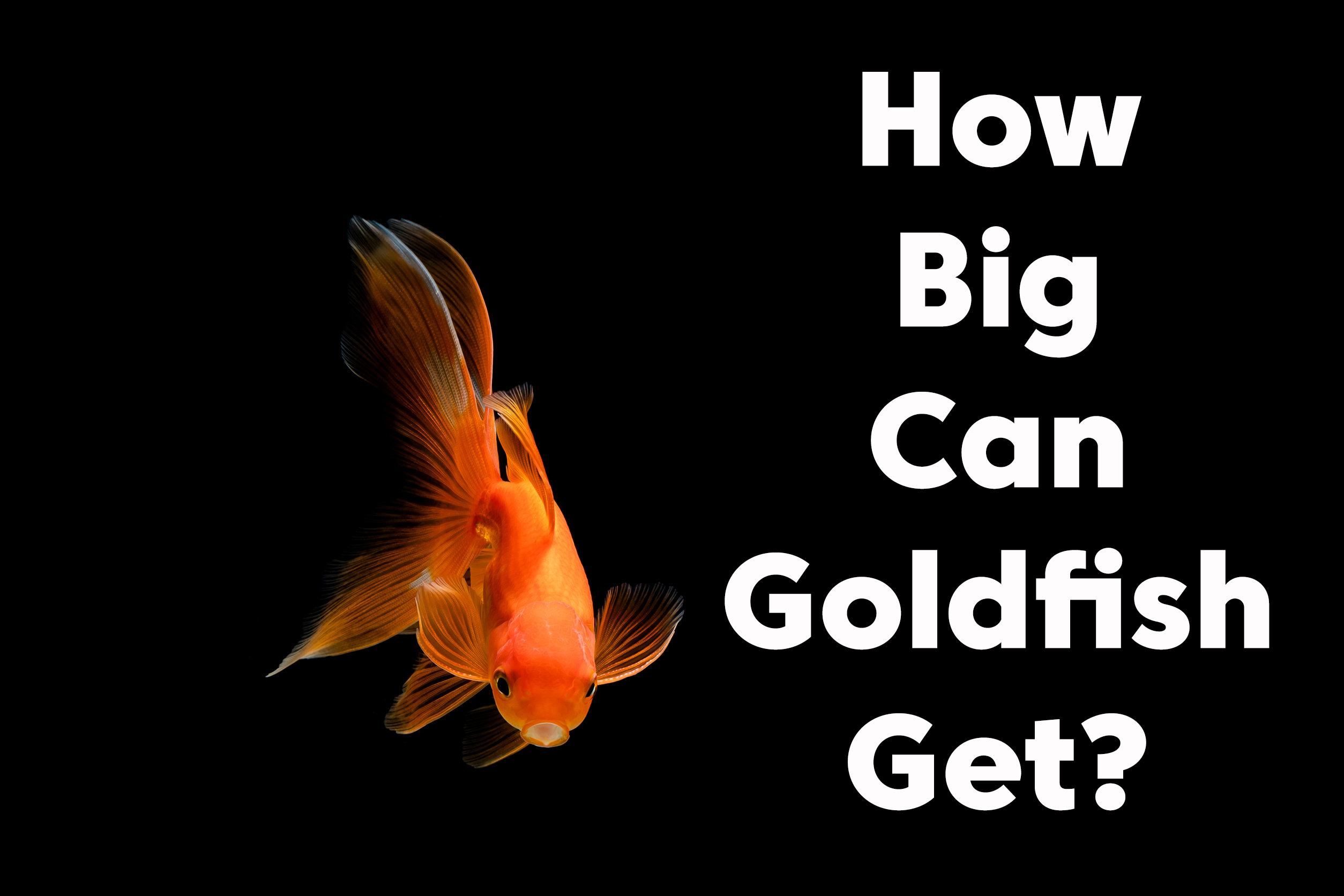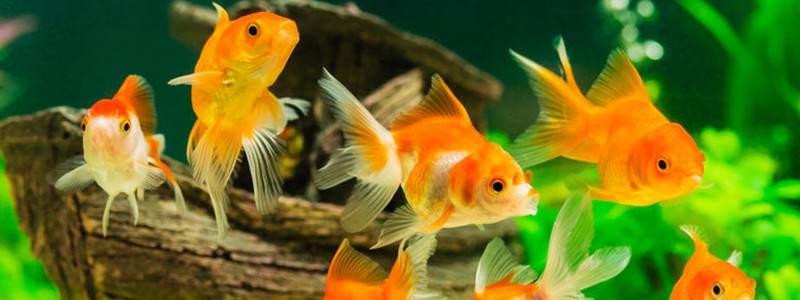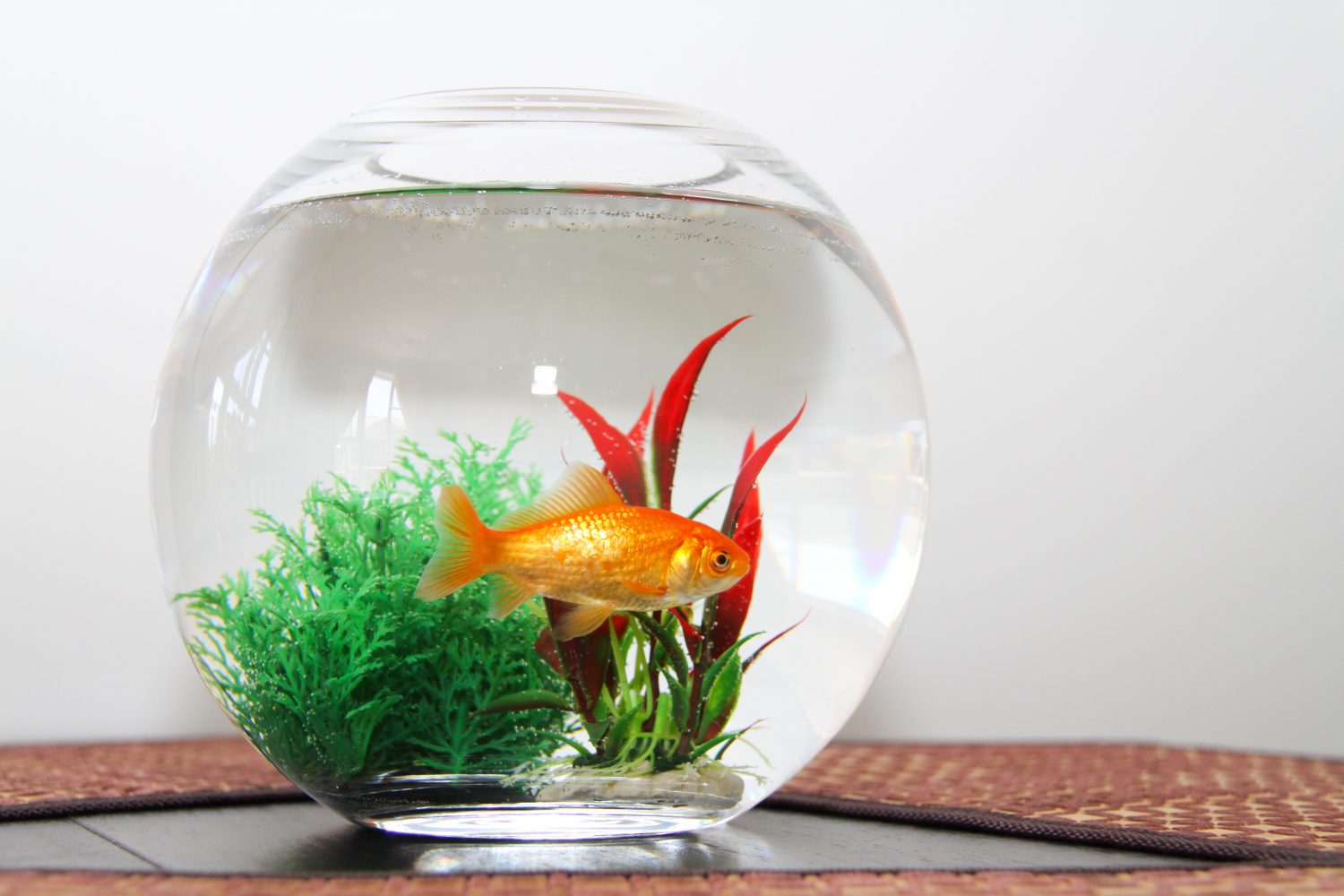It seems that nearly every series or cartoon has had at least one scene where a small goldfish is swimming sadly in a small bowl in the background. You might even know someone who kept a goldfish in a small tank or a glass fishbowl—or be guilty of doing it yourself! But are those tiny spaces really big enough for most goldfish?
Surprisingly, goldfish are not small fish. In fact, most of the common varieties sold in pet stores or given away as prizes actually grow quite large! I’m going to show you in this article how big some of the most popular goldfish really get. Most varieties of goldfish need larger aquariums to thrive, especially if you plan to keep more than one.
The Most Popular Goldfish
There are 125 types of goldfish and growing! For this article I’m going to focus on goldfish that are commonly found in your average pet store:
- Common Goldfish
- Comet Goldfish
- Shubunkin
- Popeye/Telescope Eye/Moor
- Oranda
- Ryukin/Fantail
- Veiltail
- Celestial Eye
Do you have a favorite type? Read on for more information about each one and see if you change your mind!
Common Goldfish
This little guy is the one you usually see in a plastic baggie being given away as a prize, or in a goldfish bowl swimming around all by himself. They’re also the fish you see in those overcrowded feeder fish tanks at your local fish store.
Common goldfish have a thinner body than some of the fancy types of goldfish and have compact, versus long and flowing, fins. While most of them are bright orangey-gold, they can come in white, red and white, or any other color variation.
Even though they start out small, these goldfish can reach a maximum size of 12 inches.
Comet Goldfish
Comets look almost exactly like common goldfish except for the fins. They have long, flowing fins, and some Comets have tails that are the same length as their bodies. Because of how long their tails can get, these fish max out at 14 inches.
They come in a wide variety of colors, though red and orange are very popular.
Interestingly, this is the only goldfish hybrid that was originally bred in the United States.

Shubunkin Goldfish
These goldfish can look like either the Common goldfish or the Comet, with one big difference: they have dark speckles everywhere! In fact, one of their other names is the Speckled Goldfish. They’re also called Calico Goldfish and Harlequin Goldfish because of the varied splotches of color you’ll usually find on them.
Shubunkins also have another unique color trait that most other goldfish don’t have: blue scales! The colorful splotches and speckles rest on a blue background most of the time. If you’ve ever thought about having goldfish, but couldn’t get around the bright orange color, I would highly recommend giving this fish a try.
There are three distinct tail types of Shubunkin goldfish:
- American
- Bristol
- London
American-tail Shubunkins have long tails with a deep V shape, while the Bristol-tailed Shubunkin has a large, lobed tail. The London-tailed Shubunkin has a tail that looks more like a common goldfish’s tail.
These goldish can reach a maximum length of 14 inches.
Popeye or Telescope Eye or Moor Goldfish
These fish are very popular in one particular color (black) and are also commonly known as Moors.
Black Moors are known for their large, bug eyes, placed on each side of the head, and their solid black bodies. While they can and do come in a huge selection of colors, they are widely available in fish stores in the Black Moor variety.
You’d think having large eyes would give them amazing eyesight, but actually, they don’t see very well!
One thing to note about these varieties is that their large eyes can be damaged easily, and they may not be the best choice for beginning fish keepers or for kids’ aquariums for that reason.
They can grow to a max size of four inches—the smallest goldfish on this list.
Oranda Goldfish
This is one of the most popular types of goldfish because of its unique look. Orandas have a helmet-like growth on their heads called a “wen.” These can be small, or be so large they almost cover their eyes.
It takes about two years for the wen to fully develop, and the wen may not even be noticeable on young Orandas. It is usually a different color than the rest of their head and really stands out for that reason.
Their bodies are also egg-shaped, unlike the slim and trim Common Goldfish, Comets, and Shubunkins, and this lands them in the “fancy” goldfish category, along with the rest of the goldfish on our list.
Orandas can come in a variety of colors and patterns and are often confused with another type of goldfish—the Lionhead—when they come in red and white patterning. However, the Lionhead Goldfish doesn’t have a dorsal fin, while Orandas do.
These goldfish grow to a maximum size of 16 inches, which is one of the largest sizes for any goldfish!

Ryukins/Fantail Goldfish
As you might have guessed, this type of goldfish has a long, fan-like tail. It’s also a “double tail” meaning it looks like the fish has two tails instead of one.
Ryukins are the Asian form of this fish, while Fantails are the Western version. They share many similar traits, including their fantastic tails.
These goldfish are often shown in competitions, with prizes awarded for the best tails and coloring.
They come in many colors and patterns, but two of the most popular are shimmery orange and calico, and they are also the hardiest of the “fancy” goldfish.
They can reach a maximum length of eight inches.
Veiltail Goldfish
Veiltails, also known as Broadtails, look similar to Fantails, except their fins are even longer and more flowing. Think of a long, shimmery bridal veil—for every fin on this goldfish.
Their fins make them one of the most eye-catching goldfish varieties. Their beautiful fins do come with a couple of drawbacks, though—they swim slowly, and their fins are easily damaged.
These beauties reach a maximum length of 12 inches if you include their flowing tails.
Celestial Eye Goldfish
The thing that differentiates these goldfish from the other varieties is their eyes. Instead of looking straight ahead, they stare straight up—like they’re looking at something on the ceiling. It’s a little hard to get to used to at first, but they grow on you after a while, and come in a variety of popular colors, like black, orange, and red.
These fish stay comparatively small, reaching only six inches maximum.
I compare each type of goldfish in the table below.
| Goldfish Type | Characteristics | Max Size |
| Common Goldfish | Peaceful community fish | 12 inches |
| Comets | Speedy swimmers | 14 inches |
| Shubunkins | Blue scales, three different tail types | 14 inches |
| Popeyes/Telescope Eyes/Moors | Poor eyesight, delicate eyes | 4 inches |
| Orandas | Wen above their faces | 16 inches |
| Ryukins/Fantails | Extremely hardy show fish | 8 inches |
| Veiltails | Slow swimmers; easily damaged fins | 12 inches |
| Celestial Eyes | Eyes that stare into the sky | 6 inches |
Properly Caring For Goldfish
It’s important to make sure you’re taking good care of your little (but soon to be big!) goldfish.
Buy a large enough tank for your goldfish type. Keep in mind that the smallest fish in our group can reach a max size of four inches—so a small bowl will not be appropriate for any fish on our list. In fact, some of the larger fish will need at least a 55-gallon tank if you plan to keep more than one.
Add a filter, heater, and décor—just like you would for any other type of fish! Remember, while they may be considered “cold water” fish, most goldfish still need water temperatures to remain consistently between 65-72 degrees Fahrenheit (18.3-22.2 degrees Celsius.) In most parts of the United States, that means you’ll need to purchase a heater.
Get the right tankmates. While most of the fish on this list aren’t aggressive, goldfish are omnivores in the wild. They won’t know that those pretty little neon tetras you added to the tank are supposed to be their tankmates and not their dinner. Generally, you don’t want to house larger fish with fish small enough to fit in their mouths.
Of course, there are exceptions to this rule—but with fish, it’s always better to be safe than sorry.
Also, don’t house your peaceful goldfish with aggressive or semi-aggressive tankmates—especially goldfish with long, delicate fins or delicate eyes, as these could easily be damaged by aggressive tankmates.
Do your research when looking for pond fish. While most goldfish are hardy enough to live in an outdoor pond, some aren’t. Do your homework to be sure you find the right fit for your outdoor water features.
In Summary
Goldfish grow up to be medium to large fish! These fish range in size from four to 16 inches, and have long lifespans. Be sure you get a large enough tank for the goldfish species you want, and for the number of fish you’d like to add to the tank.
While there are many beautiful varieties available, goldfish are a long-term commitment and require proper care, just like any other fish species out there.
Related Topics
If you like the article above, here are some other similar articles you should check out!
Common Goldfish Care: Lifespan, Tank Mates, Diet, and Health





